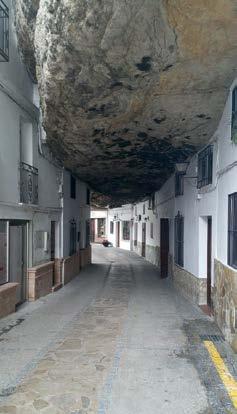
3 minute read
DIGGING THE CAVES
Unique, historic, and always cool on a hot Spring day, the village of Setenil de las Bodegas near Ronda is the perfect spot for a weekend excursion
ANDALUCIA’S white villages, the pueblos blancos, cling to mountainsides throughout the region and rank among the most beautiful in Spain.

But there’s one that deserves to be singled out: Setenil de las Bodegas, in the northeast corner of Cadiz, is unique for its cave houses and cave restaurants and shops.

The village has grown up in and around cliffs in a river valley, located less than 20 kilometres north of Ronda. Many of the homes and businesses are set into caves, with just the whitewashed façades visible under the overhanging rock face. Several of the streets are also dug into the cliff and sheltered by massive jutting boulders, some of which are draped in ivy. On the outskirts some terraces of houses jut straight into the cliff face, some with curtailed rooflines, others, somehow,
By Anthony Piovesan
with chimneys (above right). Walking through the town feels almost surreal: you just can’t imagine that a place like this exists – or that people actually live here.
Invasions
But Setenil has a population of nearly 3000, and records show there has been a village here since the 12th century - and it was certainly a settlement in Roman times.
Long before that, it was home to cave dwellers: Excavated objects show the town inhabited by troglodytes 25,000 years ago.
As the modern village grew, people dug into the cliff face and enlarged the caves, and built houses in the spaces between the rocky cliffs. This prevented them from getting too hot in the summer, and too cold in winter.
The chisel marks where caves have been excavated are still visible inside bars and restaurants. If you stay overnight in a cave house, you’ll be able to admire the handiwork while lying in bed or taking a shower.
Modern Setenil was founded in 1484, when Christian armies came from the north and expelled the Moorish rulers. It took the Christians 15 days to rid the village of the Moors who defended themselves from the castle at the top of the mountain.
The name ‘Setenil’ is believed to derive from ‘septem nihil’, a Latin phrase meaning ‘seven times no’ – in reference to the number of invasions successfully repelled. The other part of its name –‘Bodegas’ – is the Spanish for ‘store’, and refers to the caves which were once ideal for storing wine, grown in the nearby Ronda hills and popular back in ancient Rome.
Commercial wine production died out in the 19th century when phylloxera marched through, but today there are over 30 nearby vineyards (or bodegas) in the area again.
Valley walk
Setenil is a popular day trip, and on weekends you’ll see many tour buses and cars circling in search of a space. But here’s a hot tip: If you’re planning to drive to Setenil, leave your car in Alcala del Valle and take in the beautiful scenery and work up an appetite by walking the remaining three kilometres along the picturesque Arroyo de los Molinos.
On the weekends the cave restaurant terraces under the dramatic overhang on Calle Cue - vas del Sol are very busy, but in the week it’s usually quiet. They specialise in Cadiz mountain food: tasty stews, pork and chorizo; revueltos (scrambled egg mixed with black pudding or asparagus); Conejo a la serranía (rabbit) and sopa cortijera (soup made with bread, poached eggs, and asparagus). They do good desserts too: puff pastry with quince, cider dumplings, and torta de aceite – cake made with olive oil and almonds.
If booking ahead, try to get a table at La Frasquita, Bar la Escueva or La Tasca (all on Calle Cuevas del Sol) for top atmosphere and shade.

Exploring
After lunch, explore the backstreets, some of which wind up between the huge boulders to the top of the town and the ruined Moorish castle. The tourist office in a medieval building has a beautiful patterned Moorish wooden ceiling, while there is an attractive 16th century church (Our Lady of Encarnacion) built on the site of a mosque.
A steep winding staircase right by the river on Calle Cuevas del Sol leads to a lookout, the Mirador del Carmen. From here, you can see the town complete in all its beauty, its rows of whitewashed houses snaking up the mountain, the jagged cliff faces, as well as the surrounding olive and almond fields.
It’s no surprise Setenil consistently makes it onto the ‘top places to visit’ lists, and particularly after the New York Times singled it out among its Top Ten for 2019.
For more information, visit www.turismodesetenil.com
OP Puzzle solutions
Quick Crossword
Across: 7 Zoom, 8 Graduate, 9 Sparkler, 10 Nods, 11 Alive, 12 Reduced, 14 Telstar, 16 Egypt, 19 Tact, 20 Songster, 21 Aerobics, 22 Mats.
Down: 1 Compel, 2 Improvisation, 3 Agile, 4 Barrier, 5 Quinquagesima, 6 Stodge, 13 Warship, 15 Enamel, 17 Pretty, 18 Gnash.




